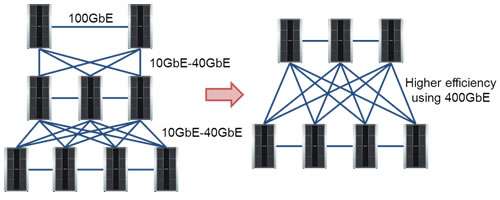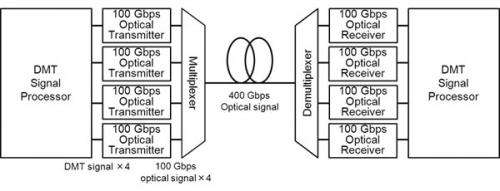First optical-transmission technology to achieve 100 Gbps using 10 Gbps transmission components

Fujitsu Laboratories today announced the development of the world's first optical-transmission technology that can achieve 100 Gbps transmission speeds using widely available, conventional components intended for 10 Gbps networking.
Increasing data-transfer rates has typically required new components designed for those higher speeds, for which existing components have not been compatible. Moreover, there is a limit to the speed improvements that can be achieved with transmission methods using the simple modulation and demodulation formats that have been used to date. Fujitsu Laboratories and Fujitsu R&D Center have applied a Discrete Multi-Tone (DMT) modulation/demodulation format(1) using digital signal processing (DSP) to transmit at 100 Gbps per channel using conventional components intended for transmission speeds of 10 Gbps per channel.
Applying this technology to an optical transceiver with four channels would result in a 400 Gbps Ethernet transceiver, which are needed in the next generation of datacenters in order to increase their data transmission speeds and processing capacity to better support cloud services.
Details of this technology are being presented at the Optical Fiber Communication Conference and National Fiber Optic Engineers Conference (OFC/NFOEC 2013), beginning March 17 in Anaheim, California. They will be demonstrated at the Fujitsu Optical Components Limited booth as "DMT Modulation Format 400GbE Transmission Demonstration".
The recent spread of cloud computing and cloud services has heightened the need for better data-processing capabilities and faster data-transfer speeds in datacenters. The optical transceivers in use today have four channels carrying a total of 100 Gbps. For the next generation of datacenters, there is a demand for Ethernet transceivers that are able to deliver 400 Gbps.

Increasing data transfer speeds requires faster transmitting and receiving circuits. However, with previous technology, existing parts could not be used, requiring new electronic and optical components compatible with the higher speeds. In addition, the simple modulation/demodulation method, in which the on/off states of the optical signal correspond to the 1/0 states of the digital signal, has limited the increase in speed.
Through the application of digital signal processing, which uses the DMT modulation/demodulation format, Fujitsu Laboratories and Fujitsu R&D Center were able to use standard direct-modulation laser components designed for 10 Gbps transmissions to achieve transmission speeds of 100 Gbps per channel. Key features of the new technology are as follows.

1. DMT modulation/demodulation format
While the DMT modulation/demodulation format is used in xDSL(2), this is the first time it has been used for optical transmissions at 100 Gbps. DMT divides the data into multiple subcarriers (carrier waves), and multi-level modulation is used for each subcarrier to achieve high transmission speeds (Figure 2). To optimize each subcarrier's power and number of multiple values, an algorithm was developed that checks receiving conditions between optical transceivers at the time the system is started up and optimizes power and the number of multiple values to suit the transceivers and line conditions.
2. Uses widely available, conventional components
Fujitsu Laboratories and Fujitsu R&D Center have developed a technology that uses existing commodity parts to achieve DMT modulation/demodulation. For example, some components have the characteristic of not being able to maintain sufficient linearity. These components can be profiled in advance and compensated for, enabling them to be used in the same way as parts that do maintain linearity.
Applying this technology to an optical transceiver with four channels (Figure 3) would result in 400 Gbps Ethernet transceivers, which are needed in the next generation of datacenters.
Through the use of this technology, high-speed transmissions at 100 Gbps were achieved using conventional components, opening the way to higher data transmission speeds and processing capacity at datacenters that support cloud services.
With an eye toward practical use of this technology, an integrated DMT modem is under consideration, and additional improvements for using existing technologies are proceeding.
Provided by Fujitsu




















